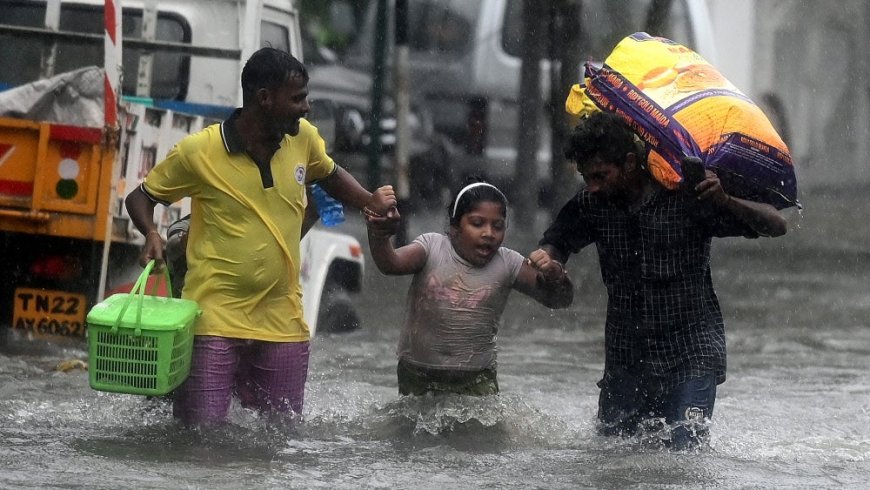Not just Chennai, a dozen Indian cities might go 3 feet under water

THE recent deluge in Chennai, triggered by Cyclone Michaung, has once again brought to light the vulnerability of Indian cities to climate-induced disasters. With over 40 cm of rainfall inundating the city within 48 hours by December 4, Chennai's plight is a stark reminder of the escalating climate crisis facing urban India.
Cyclone Michaung killed over a dozen people and left a trail of destruction in Andhra Pradesh and Tamil Nadu. The most vivid images that emerged were of submerged residential buildings and cars being washed away in water currents on inundated roads.
Though the latest flooding and destruction were the result of a cyclone, it isn't the only reason for the scale of devastation.
Chennai is no stranger to flooding; the city was submerged in a historic flood in 2015 due to heavy rainfall from the northeast monsoon. This event was a wake-up call, highlighting the consequences of inadequate urban planning and poor institutional capacity.
The causes of such flooding are multifaceted. Heavy rainfall, inadequate drainage systems and the incapacity of rivers to manage high discharge levels are primary contributors. Urbanisation plays a significant role, with encroachments on major water bodies and ecologically sensitive zones exacerbating the situation.
The flat terrain, in the case of Chennai, further complicated matters, as water failed to drain efficiently.
India's coastal cities at flooding risk
However, Chennai's struggles are part of a broader narrative of climate vulnerability across Indian cities. Kolkata and Mumbai, for example, face significant risks from sea-level rise, tropical cyclones, and riverine flooding. These densely populated metros are already witnessing the impacts of climate change, with increased intensity of rainfall and flooding, as well as heightened drought risks.
The World Bank Group's commissioned research by the Potsdam Institute for Climate Impact Research and Climate Analytics warns that India, being close to the Equator, will experience higher sea-level rises than higher latitudes. This poses a severe threat to coastal cities through saltwater intrusion, impacting agriculture, degrading groundwater quality, and potentially leading to an increase in waterborne diseases.
A report by the Intergovernmental Panel on Climate Change (IPCC) in 2021 had dire warnings for India. The most dangerous risk factor, it said, is rising sea levels that threaten to submerge 12 coastal cities in the country by the end of the century.
A dozen Indian cities, including Mumbai, Chennai, Kochi and Visakhapatnam, could be nearly three feet underwater by the end of the century, IPCC report warned.
And the risks aren't just theoretical.
More than seven million coastal farming and fishing families are already feeling the effects. Coastal erosion, exacerbated by rising seas, is estimated to lead to the loss of about 1,500 square kilometres of land by 2050. This erosion eats away at valuable agricultural areas and threatens the very existence of coastal communities.
The vulnerability of Indian coastal zones is further highlighted by the fact that low-lying coastal areas and river deltas are highly susceptible to increased flooding. Mumbai, Kolkata, and Chennai, with their dense populations and infrastructural significance, face a heightened risk of more frequent and severe floods. This could displace millions, impacting livelihoods and infrastructure.
The risk of getting flooded due to climate change isn't just for coastal cities.
Inland, too, the story is no different. Cities in Bihar, Himachal Pradesh, and Uttarakhand have suffered from monsoon-triggered flooding and landslides. Delhi too saw heavy flooding earlier this year.
In July, waters in the Yamuna swelled to a staggering 208.48 metres and flooded Delhi's low-lying areas near the banks and inundating nearby streets and public and private infrastructure. The Yamuna had breached its earlier record of 1978.
Experts blamed the encroachment of flood plains and accumulation of silt due to heavy rain in a short period for the flood in Delhi.
The floods in July also brought the focus on illicit mining and construction activities on river banks in the hill state of Himachal Pradesh.
The pattern of extreme weather events is changing, with flood-prone areas becoming drought-prone and vice versa, affecting over 40% of Indian districts.
In hill states, a large part of the destruction is blamed on unplanned urban construction in fragile settings.
Chennai floods a call to action
The response to these challenges requires a multi-faceted approach. Building codes must be strictly enforced, and urban planning must anticipate climate-related disasters. Coastal embankments and strict enforcement of Coastal Regulation Zone codes are necessary to protect against sea-level rise. Additionally, watershed management and the adoption of the 'sponge city' concept could mitigate flood risks.
India's policymakers are not oblivious to these threats. The Mumbai Climate Action Plan (MCAP) 2022, for instance, aims to increase the city's climate resilience through evidence-based planning. Moreover, improvements in hydro-meteorological systems and the installation of flood warning systems can help citizens prepare for and respond to impending disasters.
Yet, the challenge remains daunting. Climate change is intensifying the natural water cycle, bringing more intense rainfall and associated flooding, as well as more intense drought in many regions. Indian cities must adapt to this new reality by integrating climate risk into their development plans and actions.
The recent flooding in Chennai is a stark reminder and a call to action to build cities capable of withstanding the unpredictable and severe impacts of a changing climate. As Indian cities continue to grow and attract more residents, there has never been a greater urgency for resilient infrastructure and sustainable urban planning.
